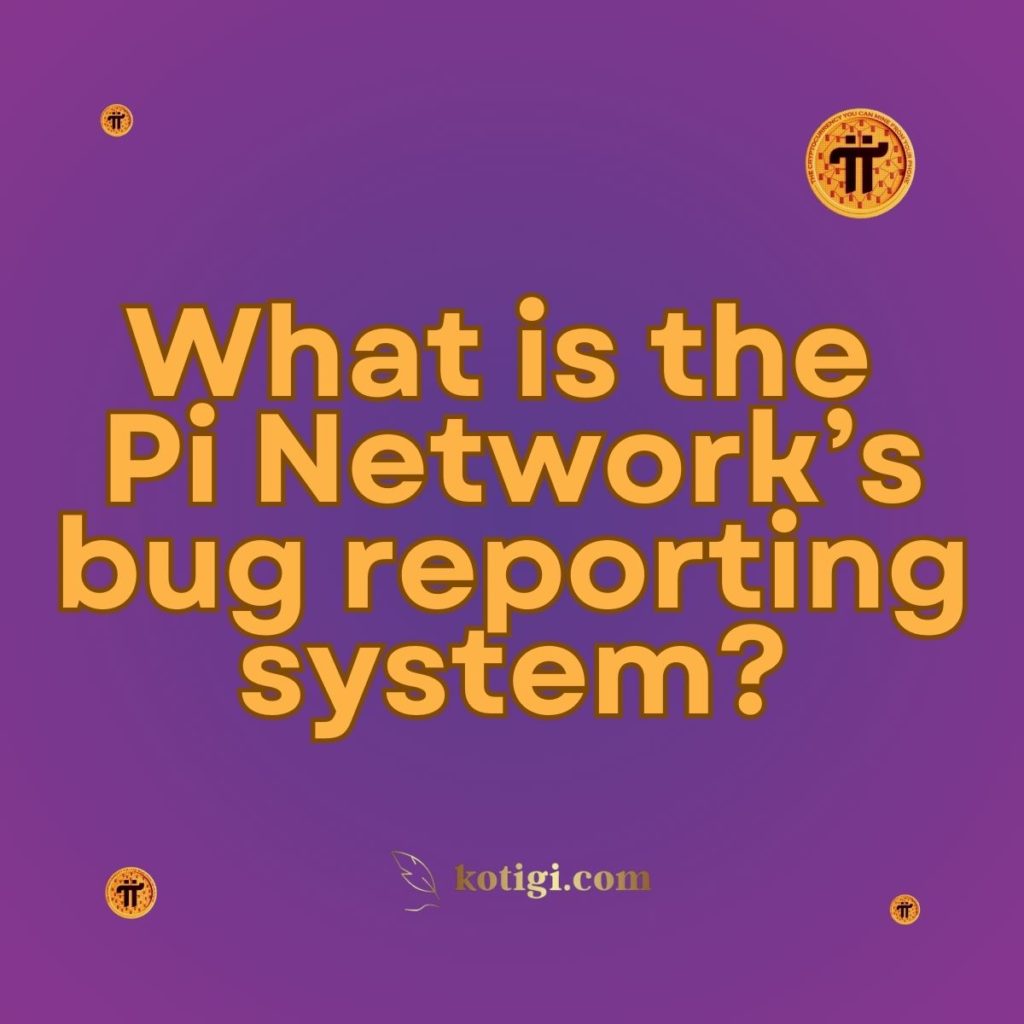
What is the Pi Network’s bug reporting system?
The Pi Network’s bug reporting system is a structured process that allows users to report technical issues or bugs they encounter on the platform. Through channels such as the Pi Network Support Portal, in-app feedback, and community forums, users can submit bug reports that are then addressed by the development team. This system ensures that any issues affecting the functionality or user experience are promptly identified and resolved.
Introduction
As the Pi Network continues to expand, its technological infrastructure becomes increasingly complex, leading to occasional bugs or technical glitches. A reliable and efficient bug reporting system is crucial for maintaining platform stability and ensuring a smooth user experience. By offering multiple channels for users to report bugs, Pi Network can identify and fix problems swiftly. This post will dive into how the Pi Network’s bug reporting system works, the different ways users can report issues, and how the development team prioritizes and resolves bugs to maintain the platform’s integrity.
Pi Network Support Portal for Bug Reporting
One of the primary methods for reporting bugs on Pi Network is through the Support Portal.
How to Access the Support Portal?
The Pi Network Support Portal can be accessed via this link. This platform allows users to submit detailed bug reports, which are then escalated to the development team for investigation and resolution.
Reporting Process
The process of reporting bugs through the support portal typically involves:
- Filing a Ticket: Users can open a new ticket describing the bug they encountered. They are encouraged to provide as much detail as possible, including screenshots, steps to reproduce the bug, and the type of device being used.
- Categorizing the Bug: Users are required to select a category for the bug report, such as app crashes, mining errors, or connectivity issues. Proper categorization ensures the report is directed to the right team.
- Tracking the Report: Once the ticket is submitted, users can track the status of their report through the portal. They receive updates as the development team investigates the issue and works toward a solution.
Benefits of the Support Portal
- Centralized Reporting: The support portal acts as a centralized location for all bug reports, making it easier for the development team to track recurring issues and prioritize fixes.
- User Transparency: Users have full visibility into the status of their reports, which fosters trust and improves the overall support experience.
In-App Feedback for Bug Reporting
In addition to the support portal, Pi Network provides an in-app feedback system that allows users to report bugs directly from within the Pi Network app.
How to Report Bugs In-App?
Within the Pi Network app, users can report bugs through the “Feedback” or “Help” section. The in-app feedback system is designed to make bug reporting easier and more accessible, especially for users who encounter issues while actively using the app.
Key Features
- Real-Time Bug Reporting: Users can report issues as soon as they encounter them, allowing for immediate documentation of the problem.
- Simplified Process: The in-app feedback system simplifies the reporting process by automatically gathering information about the user’s device, operating system, and app version. This helps the development team replicate the issue and find solutions more quickly.
Common Bugs Reported via In-App Feedback
Some of the most frequently reported bugs through the in-app system include:
- App Crashes: Sudden crashes or freezes while using the app.
- Mining Errors: Issues with incorrect Pi rewards or errors related to the mining process.
- Performance Glitches: Lag, slow loading times, or issues with app responsiveness.
User-Friendly Experience
The in-app feedback system is designed to be user-friendly, ensuring that even users with minimal technical knowledge can easily report bugs and contribute to improving the platform.
Community Forums and Peer Reporting
Pi Network’s community forums also play an important role in the bug reporting system.
Role of Community in Bug Reporting
The community forums, which are accessible through official Pi Network channels, allow users to discuss common bugs or issues they are experiencing. By sharing information and solutions, the community can help identify bugs that affect a large number of users.
Common Bugs Discussed in Forums
Some common issues frequently discussed and reported via community forums include:
- Synchronization Errors: Problems with mining rewards or transaction data not syncing correctly between devices.
- Account Verification Bugs: Issues related to KYC (Know Your Customer) verification, where users experience delays or verification failures.
- Connectivity Problems: Network-related bugs that prevent users from accessing the app or engaging in transactions.
Community Moderation and Official Responses
The forums are often moderated by Pi Network representatives who can escalate reported bugs to the development team. In addition, official representatives may provide updates on known issues and offer temporary solutions or workarounds.
Collaborative Bug Resolution
Users often collaborate to provide potential solutions for minor bugs, such as app performance tweaks or steps to temporarily fix the problem until an official patch is released. This collaborative approach allows for quicker identification and resolution of widespread issues.
Development Team’s Role in Bug Resolution
Once bugs are reported through the support portal, in-app feedback, or forums, the Pi Network development team is responsible for investigating and resolving the issues.
Bug Prioritization
Bugs are categorized based on their severity and the number of users affected. The development team prioritizes bugs that:
- Affect a large number of users: Bugs that disrupt the platform for a significant portion of the user base are treated with higher urgency.
- Cause app crashes or security vulnerabilities: Critical bugs that lead to app crashes or expose security risks are given immediate attention.
- Impact the mining process: As mining is a core function of the Pi Network, any bugs related to mining rewards or performance are escalated quickly.
Resolution Process
Once a bug is identified, the development team goes through the following steps:
- Replication: Developers attempt to replicate the issue in a controlled environment to fully understand the bug’s cause.
- Fix Development: After replication, the team works on a solution, either by fixing a piece of code or updating system configurations.
- Patch Deployment: Once the fix is ready, it is tested and then deployed to the platform through updates or emergency patches.
Update Cycles
Pi Network typically rolls out updates on a scheduled basis. However, critical bug fixes may be deployed immediately to ensure platform stability. Users are notified about the bug fixes through app updates and official announcements.
Escalation for Major Bugs and Incidents
Major bugs that disrupt the platform significantly or affect user security require a more robust response.
Incident Management
Pi Network has an incident management protocol in place for handling major bugs or platform-wide issues. This process involves:
- Immediate Bug Reporting: Users can report major bugs through any of the available channels, including support, in-app feedback, or forums.
- Specialized Development Team: A specialized development team is tasked with addressing high-priority bugs and restoring platform functionality as quickly as possible.
- User Communication: During a major incident, Pi Network provides regular updates to users through official channels, keeping them informed about the progress of the bug resolution.
Post-Incident Analysis
After a major bug is resolved, the development team conducts a post-incident analysis to identify the root cause and prevent similar issues in the future. This process helps improve platform resilience and ensures long-term stability.
User Feedback on Bug Reporting System
The user feedback loop is essential to improving Pi Network’s bug reporting system.
Gathering User Feedback
After bugs are resolved, users are often asked to provide feedback on their experience with the reporting process. This feedback is used to enhance the system’s efficiency and ensure that users find the process seamless and effective.
Improvements Based on Feedback
Based on user feedback, Pi Network may:
- Simplify the reporting process: Adjusting the support portal or in-app feedback system to make it easier for users to report bugs.
- Enhance communication: Improving the communication between the development team and users regarding the status of their bug reports.
- Reduce turnaround times: Shortening the time it takes for bugs to be resolved by optimizing internal processes.
Continuous System Enhancement
The bug reporting system is continuously evolving, with Pi Network investing in new tools and technology to make the process faster, more user-friendly, and more efficient.
Future Enhancements to Pi Network’s Bug Reporting System
Pi Network aims to further improve its bug reporting system by leveraging advanced technologies and expanding its support capabilities.
AI-Driven Bug Reporting
In the future, Pi Network may integrate AI-driven bug detection into its platform. This technology would automatically detect and report bugs without requiring user input, ensuring that issues are identified and resolved faster.
Expanded Support Channels
Pi Network plans to expand its bug reporting channels to include more real-time communication options, such as live chat support and automated troubleshooting bots. These channels would provide users with faster responses and more immediate solutions to their problems.
Improved Feedback Mechanisms
Enhanced feedback mechanisms, such as surveys and automated follow-ups, will help Pi Network gather more detailed insights from users about their bug reporting experiences. This will allow for continuous improvement of the system.
Conclusion
Pi Network’s bug reporting system is a well-structured and essential part of maintaining a stable platform. With multiple reporting channels like the support portal, in-app feedback, and community forums, users have several ways to report bugs and contribute to the improvement of the network. The development team prioritizes and resolves bugs efficiently, ensuring that Pi Network remains a reliable platform for its users. As Pi Network grows, it remains committed to enhancing its bug reporting process, incorporating user feedback, and leveraging new technologies for faster and more effective issue resolution.
Key Takeaways
- Pi Network’s bug reporting system consists of multiple channels, including the support portal, in-app feedback, and community forums.
- Users can report bugs through the Pi Network Support Portal for a more detailed and tracked process.
- In-app feedback allows users to report bugs in real-time, simplifying the process and providing immediate assistance.
- The development team plays a crucial role in identifying, replicating, and fixing bugs based on user reports.
- Major incidents are handled through a dedicated incident management protocol, ensuring quick responses to platform-wide bugs.
- User feedback is continually gathered to improve the bug reporting system, making it more efficient and user-friendly.





